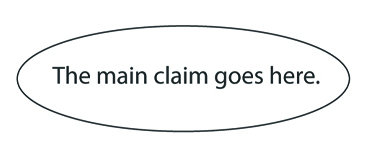1 Recap of the argument-mapping recipe in action
Before applying the recipe for argument mapping, for your convenience, it is repeated here in its entirety.
Recipe: from words to maps
How to create an argument map based on the argument in a short piece of text
First step: Identify the main claim. First, try to find the main claim. The main claim is the overall point or conclusion that the author of the text is making. The text presents information that directly or indirectly supports or opposes the main claim. The main claim can be explicit or implicit:
- If the main claim is explicit, one or more of the statements in the text put this claim forward.
- If it is implicit, you will need to infer the main claim that the author is trying to get across. Once you have inferred the implicit claim, state it in your own words.
Once you have identified the statement(s) that make the main claim, or you’ve stated the implicit main claim in your own words, you can start the argument map. Place the main claim in the top-level oval, as shown in Figure 1.
Second step: Find text supporting and/or opposing the claim(s) found at the previous level. Now, you need to find parts of the text that directly oppose or support the claim at the previous level. Read the text from the beginning to the end. For each statement, ask yourself the question ‘Does it support or oppose the claim at the previous level?’ Add these claims to your map and connect them, using the oppose or support relationship, to a claim at the previous level.
Repeat: Proceed with the next level. Now, repeat the procedure in the second step for the next level by searching for statements that oppose or support the statements you identified at the previous level. Keep adding further levels until you hit a level at which you can no longer find supporting or opposing claims for the previous level.
The final ‘repeat’ step of the recipe asks you to continue until no more opposing or supporting claims can be found in the text. Sometimes, a text will include statements that are not part of the argument that is put forward. For instance, some statements may summarise, describe or explain something. Such statements should not be included in your argument map, if they are not meant to oppose or support a claim. As result, not all of the information in a text will necessarily be included in your argument map.
In the next three sections, you will make argument maps for short arguments. You will build your maps step-by-step. At each point, you will be able to check your work against the solutions that are provided. But do try each step yourself first, before looking at the solution! Think of each of these mapping activities as a puzzle. Hopefully, after some practice, you will get the hang of it and enjoy the challenge of dissecting an argument.
Don’t worry if your maps don’t always exactly match the ones provided. Sometimes, there are different, equally valid, ways of mapping the same text. That is fine as long as you can defend the reasoning behind your own map. And of course, ideally, you should also be able to understand the reasoning behind our maps, once you see them.

